One focus of the latest report from the UN panel on climate change is the impact on Earth's ecosystems. The report from the Intergovernmental Panel on Climate Change (IPCC) says that in recent decades, many plant and animal species have moved their range, changed numbers or shifted their seasonal activities as a result of warmer temperatures.
Moving on up
Species are matching temperature rises by increasingly shifting their range (the geographic area to which their activity is confined) towards the cooler poles or higher altitudes – sometimes three times faster than previously thought. Species that already inhabit the upper limit of their habitat – such as the polar bear, snow leopard or dotterel – literally have nowhere left to go.
The British comma butterfly has moved 137 miles northward in the past two decades, while geometrid moths on Mount Kinabalu in Borneo have shifted uphill by 59 metres in 42 years. The quiver tree of southern Africa is increasing as it moves towards the south pole, but dying of heat and water stress in its shrinking northern range. Dartford warblers have been steadily moving northwards in the UK while declining on the southern edge of their range in Spain.
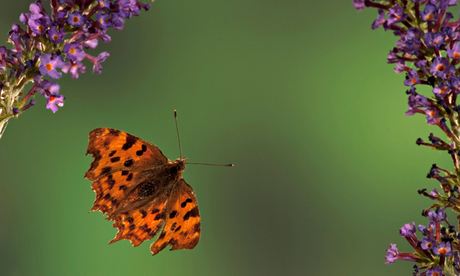 A comma butterfly in Kent, UK. Photograph: Robert Pickett/Alamy
A comma butterfly in Kent, UK. Photograph: Robert Pickett/Alamy
In the seas, rising numbers of warm-water crustaceans have been found around Norway's polar islands, while the snow crab has extended its range northwards by up to 311 miles. The IPCC report warns that many species will be unable to move fast enough to track suitable climates, with plants, amphibians and small mammals in flat landscapes or that remain close to their breeding site particularly vulnerable.
Seasonal shift
For many species, climate influences important stages in their annual life cycle, like migration or mating. The report shows major shifts in this "phenology" in recent decades, mainly in the northern hemisphere. "Spring advancement" – the earlier occurrence of breeding, bud burst, breaking hibernation, flowering and migration – has been found in hundreds of plant and animal species in many regions. Migratory birds including the whitethroat, reed warbler and song thrush are arriving earlier, three species of Japanese amphibians have been found to be breeding earlier, while the edible dormouse has been emerging earlier from hibernation by an average of eight days per decade.
Squeezed-out species
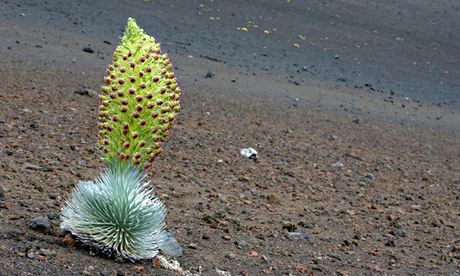 Silversword plants in Haleakala Crater on Maui, Hawaii. Photograph: Scott Sharick/Alamy
Silversword plants in Haleakala Crater on Maui, Hawaii. Photograph: Scott Sharick/Alamy
Climate change will reduce the "populations, vigour and viability" of species confined to small, isolated habitats, the report warns. The mountain pygmy possum of Australia is being affected by warmer winters, emerging from hibernation before its prey, the bogong moth, and often dying of starvation. The spectacular Haleakala silversword lives only on a single volcano summit in Hawaii, but shifting weather patterns have made the plant's environment too dry and warm for new seedlings to survive, and older plants are dying off.
Tree deaths
Higher rates of tree death and forest dieback have been increasingly attributed to climate change. While warmer temperatures are making North America's forests more vulnerable to infestations from insects like the ips, spruce, fir and mountain pine beetles, sizeable areas of forest in Australia, Russia, France and other countries have experienced die-offs, mostly caused by drought, high temperatures, or both.
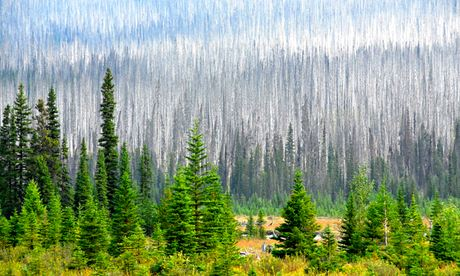 Young, healthy pine trees stand in stark contrast to the pines killed by pine beetles near Radium Hot Springs, eastern British Columbia, Canada. Photograph: Udo Weitz/Getty images
Young, healthy pine trees stand in stark contrast to the pines killed by pine beetles near Radium Hot Springs, eastern British Columbia, Canada. Photograph: Udo Weitz/Getty images
Invasive species
Since the 2007 IPCC report, the spread and establishment of alien species attributed to climate change has increased, helped by longer seasons and warmer weather. The Asian tiger mosquito is now prevalent in several southern European countries but projections show it is likely to extend its range further north. In Svalbard, the present risk posed by invasive species is relatively low due to the cold polar seas. But under scenarios where oceans continue to warm, the number of invasive species such as the European green crab, Japanese ghost shrimp and club sea-squirt are predicted to increase six-fold.
Extinction
Changes in climate have been identified as one of the key drivers of extinctions of amphibians, with more than 160 probable extinctions in the last two decades, many in Central America. The most notable cases have been the golden toad and the Monteverde harlequin frog. The report warns that many species face increased extinction risk as climate change adds to existing pressures such as habitat loss, exploitation, pollution and invasive species.
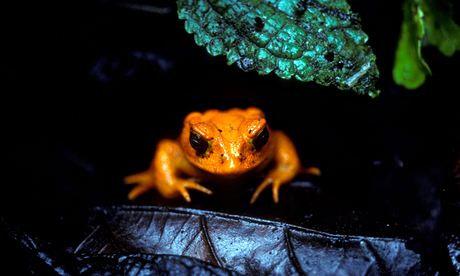 A golden toad (Bufo periglenes) in Monteverde Cloud forest reserve in Puntarenas province of Costa Rica. Photograph: Robert Fried/Alamy
A golden toad (Bufo periglenes) in Monteverde Cloud forest reserve in Puntarenas province of Costa Rica. Photograph: Robert Fried/Alamy
Warmer, rising seas
Both warm water coral reefs and Arctic ecosystems are already experiencing irreversible regime shifts, the report warns. Sea temperatures of 29.2C determine a 50:50 sex ratio in green, hawksbill, leatherback, loggerhead and olive ridley turtles. Scientists say higher temperatures will lead to the feminisation of populations and affect breeding rates. As sea ice melts, the bowhead whale and the narwhal will lose protective cover, while other species such as the ringed seal will struggle to breed. Whales, fish and birds will all suffer from declines in the zooplankton (krill, fish and cephalopods) on which they feed. A predicted decline in algae, a vital nutrient that grows beneath the Arctic sea ice, will mean less food for cetaceans. Sea temperature changes are threatening the availability of sandeels, a major food source for seabirds including kittiwakes and guillemots, whose colonies in Scotland have seen major population crashes. Rising sea levels mean species like the swan goose will lose important wintering grounds on coastal mudflats and estuaries. With less prey available, the birds will have less energy for migration.
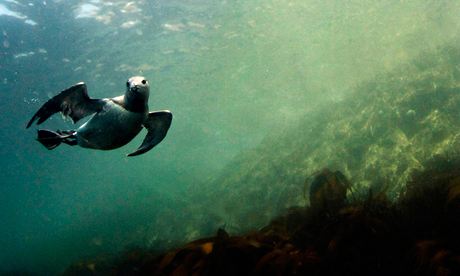 A guillemot swims underwater by the Farne Islands off the Northumberland coast, northern England. Photograph: Nigel Roddis/Reuters
A guillemot swims underwater by the Farne Islands off the Northumberland coast, northern England. Photograph: Nigel Roddis/Reuters
Earth's ecosystems
The IPCC report documents the impact of climate change not only on just species, but entire biomes and ecosystems. The high northern latitudes are warming more rapidly than other parts of the Earth, with climate models predicting a northward shift of Arctic vegetation that will see the boreal biome (coniferous forest across North America and Eurasia) migrate into what is currently tundra (treeless plains of the Arctic). This shift is being marked by evergreen trees, which have increased their growth at the margins of the tundra while simultaneously dying off at the southern limits of the boreal forest in recent decades. The loss of the treeless tundra will greatly reduce suitable habitat area for species such as the Siberian crane, which requires open ground to nest.

